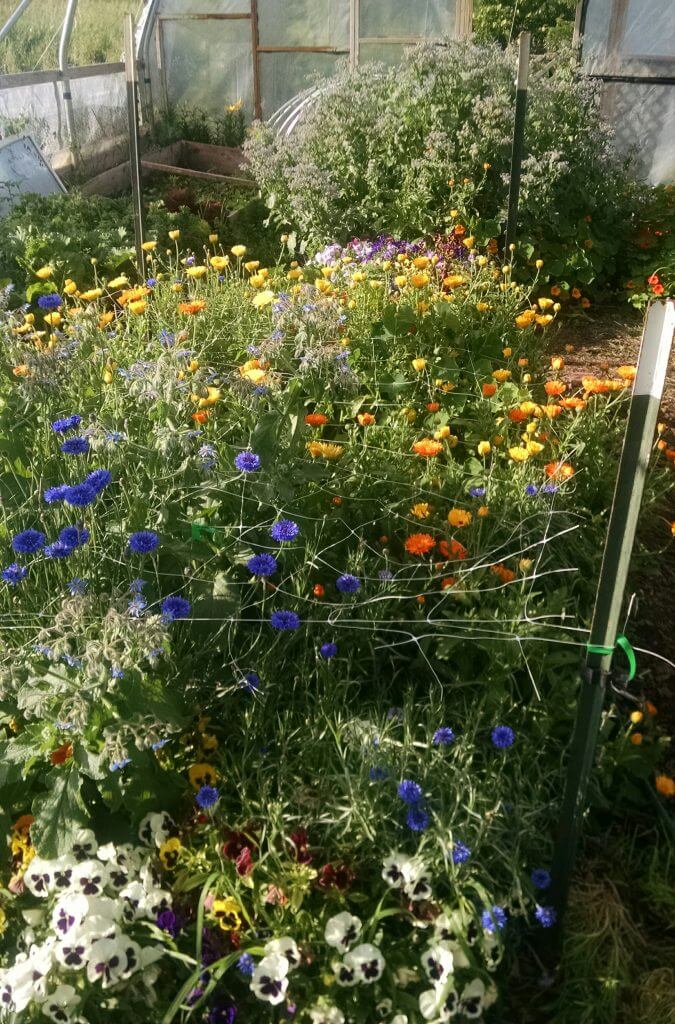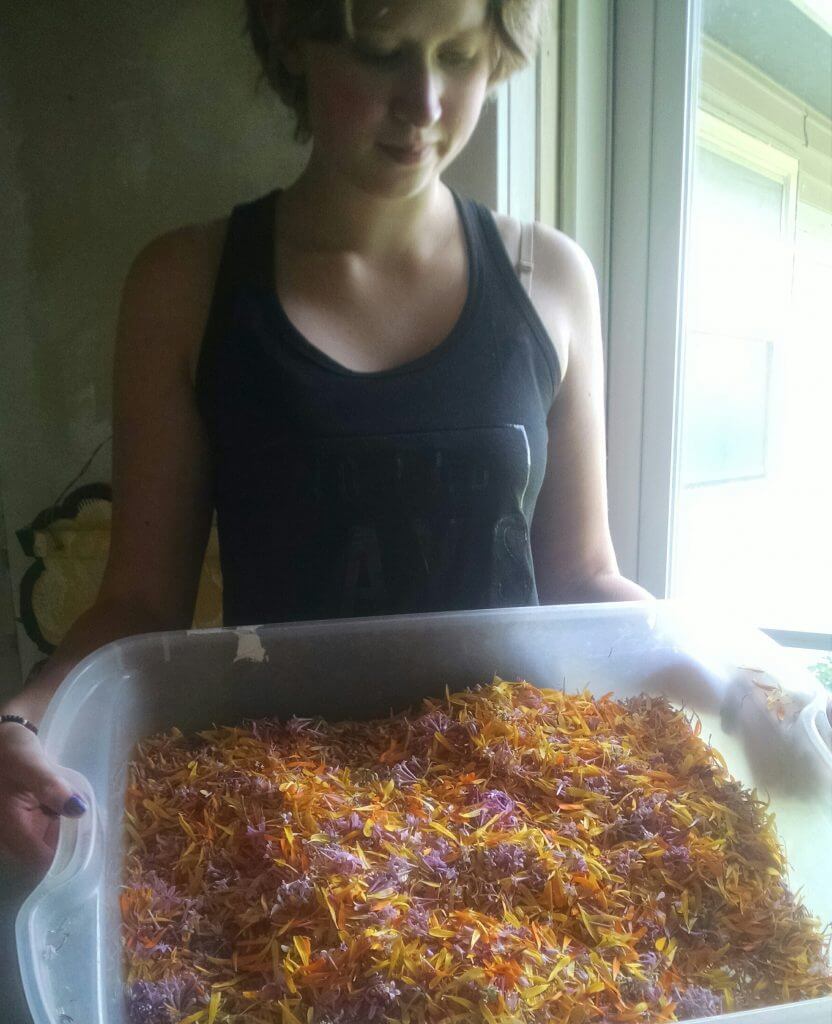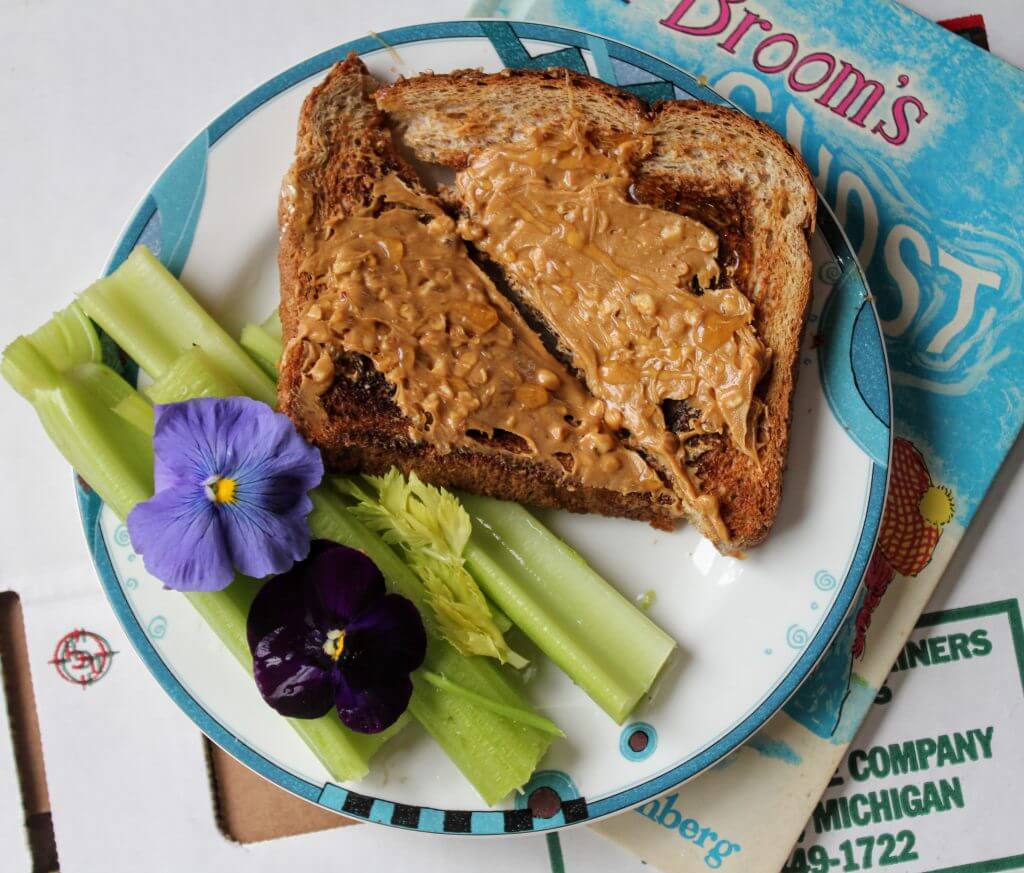Edible flowers: why, how, what, and wheretofore!

Here’s the beautiful mess of edible flowers–just some of them!–growing in my hoop house right now. From the foreground: pansies, bachelor buttons, calendula, nasturtiums, borage. 🙂
You knew it was coming, didn’t you, my patient Gentle Reader?
I can’t do something like raise and sell edible flowers for very long before I have to sit down and write about them. For me, to write about something is to understand it better, to organize it in my mind, to know it better.
And sharing with you my love of growing edible flowers, and how much I enjoy using them in my own kitchen, is something that I must do. Today. 🙂 I’ll share with you WHY you maybe just oughta consider planting a few edible flowers in your garden spaces this year, and then we’ll move on to HOW to figure out which ones are edible, and then we’ll brainstorm some ideas for WHAT to do with all the flowers that you will grow! Ready? Set . . .
Here we go: the WHY you probably ought to plant some edible flowers in your garden today.
I have always grown plenty of flowers in my veggie gardens, edible and non-edible alike. I like flowers. Flowers are pretty and smell good. What’s not to like? There are aesthetic reasons as well as practical ones for doing this. Oh, geez, this is entirely another blog post, but you can trust me on this. Just to touch on it, though:
- Aesthetic: You are weeding the carrot patch, which is an onerous (but necessary!) chore to be sure, and you look over and take a momentary break as you admire the borage flowers, buzzing with bees*. And the marigolds that you were thoughtful enough to plant near the tomato row. And the nasturtiums that you planted near the green bean bed. Your heart, momentarily, is lifted as you gaze at something so lovely. You may hang a beautiful painting in your kitchen for the same reason: Beauty lifts the heart. And to me, beauty points my heart to God. It elevates my spirit from the dirt to greater things.
- Practical: The borage flowers, again, which are buzzing with bees, will attract the same valuable pollinators to visit the tomato blossoms, the basil blossoms, and the bean blossoms. This is becoming more and more important, as the number of insects (especially pollinators) declines worldwide. Can you imagine it: maybe some sad day soon we will be competing to see who can get the few pollinators left in our area to our places? But let’s not go there today. That’s another issue entirely. There is too much to discuss. I do think that planting specifically to attract pollinators will become more and more important.
- Oh, okay, one more: Of course there are many edible flowers that actually make sense in pairing with other plants in your garden. For example, borage deters tomato hornworms and cabbage moths, so you are a very smart cookie, indeed, if you choose to grow it near your tomatoes and cabbages, too. You’ve heard of this book, right? It’s a valuable resource for all garden freaks, like ya’all. Oh, and hearken to this, science geeks: Many varieties of Marigolds produce alpha-terthienyl, which is a substance that suppresses nematodes, which are (as you know!) naughty microscopic worms that attack the roots of plants. They also suppress other disease-causing agents. Hey. I just had a thought: many of the corn and beans farmers who live and work around me plant fall crops of radishes and turnips to combat (wait for it!) nematodes in the soil. How awesome would it be if they planted marigolds, instead? Acres and aces of marigolds. How pretty would that be? Swoooon. I would LOVE it. I’ll have to put a bug into the ears of some of my farmer friends.
So here’s a question for you, dear gentle reader . . . you are at the feed store, or the discount store, or the nursery and you see a display with marigolds, or dianthus, or bachelor buttons, or some other pretties with the price slashed! You’ve got your garden planted already. There’s not much space left, except for the odd corner or spot. There’s really no good reason for taking advantage of the sale and buying some flower plants for your veg garden, right? Wrong! The bees and butterflies will love you, and your veg plants will love you, too, if you plant a few pretty posies in your veg garden. And we all want to be loved, right?
There are more great reasons (your little granddaughter will have flowers to pick when she comes to visit you 🙂 ) of course, but I’ll leave it at that for now (you’ll always have flowers of some sort on your table), since we really need to get to the point (I have been accused of veering off it, the point, I mean) like, today sometime.
So there’s the WHY you maybe ought to consider planting some edible flowers in your garden spaces.
Now the WHICH ONES ARE EDIBLE part of this post. And the NOT poisoning yourself or your loved ones part. Okay. I’ve been selling edible flowers for nearly two years now, and I’ve learned a lot about safety during that time. I take this seriously. As you ought to, too, if you plan to dabble in edible flowers.
There are many, many good reasons for not wanting to (unintentionally) poison yourself or your loved ones. That much is commonly known.
There are a number of books and other resources on edible flowers, and lots of information online too, of course. My simple rule of thumb, in identifying which flowers are edible:
- Identify each flower carefully, using online resources or state identification guides. A local extension office may be a good resource, and also your seed catalogs. I am partial to this list, by the way.
- When in question, consult a local expert on edible flowers.
- If there are any conflicting reports from the sources (three say it’s edible, one says it’s not) don’t take a chance.
It’s just not worth the risk!
- When in doubt, don’t eat it. Tattoo this on your wrist. When in doubt, don’t eat it. It bears repeating.
Now, a cautionary addendum to this method: just because one type of flower is edible, doesn’t mean that every variety of that type is. A friend reported to me that she heard that daylilies were edible, only to eat several of them, and then get sick. She found out later that only one cultivar of daylily is edible, after the fact. (The original daylily, the unspotted orange ones that grow wild in the ditches around here, are the only truly edible ones. This is an example of a controversial flower that I would avoid, by the way.)
That, by the way, is the Reader’s Digest version of this issue.
So you’ve determined which flowers are edible, so what do you do with them?
There are some fancy ways that you can use edible flowers in your own kitchen, and most will take just a soupçon of effort:
1. Crystallize small blossoms (borage works well) and use as a decoration for cakes and other pastries. (Admittedly, this is a tedious job, but beautiful: Martha is a good resource, at this juncture.)
https://www.youtube.com/watch?v=thSRppVshXA
2. Freeze small blossoms in individual ice cubes and use in drinks (again, borage works well).
3. Flavor and beautify vinegars with blossoms.
4. Add to your favorite vinaigrette or salad dressing recipe.
Then there are some ways to use edible flowers that take almost no effort at all! Just pick a few and . . .
1. Sprinkle in green salads.
2. Shred and sprinkle petals across any plate you want to fancy-up.

I had a very large order of mixed petals, and Amalia helped me with it. Isn’t it pretty?
3. Add to fancy drinks. Or add to plain drinks, and voila! Now they are fancy!
4. Use a stiff stemmed flower as a swizzler stick (dianthus, small amaranth, and any other edible flowers with a stiff stem work well).
5. Garnish any plate. Elevate the humble! Beautify the ordinary. Like this:

Elevate even something as simple as toast with peanut butter and honey, with a couple of pretty edible flowers. (This is a savvy mom move!)
6. Decorate a cake. I’ve done this so many times! Use your imagination and have fun!
Oh, there are so many more ways you can use these pretties!
Well, gentle reader, I finally got to the end of this post. I have been working on it for so long, and there’s so much more that I could add, but this is probably long enough for now, isn’t it? Now I have a question for you: have you ever used edible flowers in your own kitchen? Do you grow any flowers specifically for adding to your meals? I would love it if you shared this with me in the comments.
And, boy howdy, if you felt like sharing this post with your friends, I’d be over.the.moon. 🙂
Thanks for popping in, and I hope you have a lovely day!
*hugs*




Yes, I have used them, back in the day however you really do not see much of them here in Mexico. Of course, we don’t hang out at the high-end restaurants so perhaps there are some places where they are served in a salad or with a dessert. The weather here is so hot that I believe they would need to be grown in another part of Mexico and trucked in. We do have wonderful to look at flowers in Puerto Vallarta and the wild parrots seem to like them but I will forgo that adventure. Nice opening picture.
Thanks, Chef. I don’t eat at the fancy-schmancy restaurants that buy my flowers, but one of them, at least, is very good about posting pictures on social media, so I get to see how they use some of them, at least. We use them liberally in our own meals, and that is fun!
Ummmm, Amy – somehow you forgot to mention that you earn a significant part of your daily bread by harvesting and selling those edible flowers. I think that most of your gentle readers would be hugely surprised by how many flowers you sell every week.
But I can think of a lot less pleasant ways to earn a living!
Ummm, Gene, oh, did I not mention that? Well, now I will consider it mentioned, thanks to your nice comment. 🙂